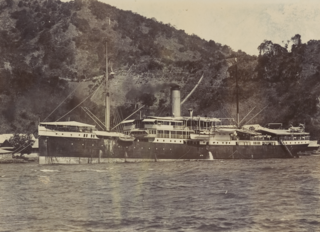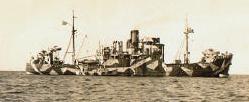
Deutsche Schiff- und Maschinenbau Aktiengesellschaft was a cooperation of eight German shipyards in the period 1926 to 1945. The leading company was the shipyard AG Weser in Bremen.

USS Pequot (ID-2998) was a cargo steamship that was built in 1910 for DDG Hansa of Germany as Ockenfels. She was the second of three DDG Hansa ships to be named after Ockenfels in the Rhineland-Palatinate.

Koninklijke Paketvaart-Maatschappij, was a Dutch shipping line in the Dutch East Indies, now Indonesia. It traded form 1888 to 1966. It was the dominant inter-island shipping line in the Dutch East Indies in the last half-century of the colonial era.

SS 's Jacob was a passenger steamship that was launched in the Netherlands in 1907 and sunk by enemy action off New Guinea in 1943. She spent most of her career with Koninklijke Paketvaart-Maatschappij, based in the Dutch East Indies.

Operation Lilliput was the name given to a convoy operation directed by G.H.Q. Operations Instructions Number 21 of 20 October 1942 for transportation of troops, weapons, and supplies in a regular transport service between Milne Bay and Oro Bay, New Guinea between 18 December 1942 and June 1943 in order "to cover reinforcement, supply, and development of the Buna-Gona area upon its anticipated capture" by the Australian 7th Division and the United States Army's 32d Division. Within six months, the convoys, escorted by Royal Australian Navy corvettes and largely composed of Dutch KPM merchant ships, had delivered 60,000 tons of supplies and 3,802 troops from Milne Bay to Oro Bay. Corvettes provided the majority of the escort force. Losses during Imperial Japanese air attacks amounted to two merchant ships, 's Jacob and Van Heemskerk, sunk and two badly damaged while several of the corvettes also sustained damage and casualties.

SS Uhenfels was a German-built heavy-lift ship that was launched in 1931 for DDG Hansa. She was captured by the Royal Navy in 1939, two months after the start of the Second World War. The UK Ministry of Shipping renamed her Empire Ability and contracted Elder Dempster Lines to operate her. In 1941 a German U-boat sank her by torpedo.
Stettin was a 2,646 GRT cargo ship which was built in 1923 for the Stettiner Dampfer Compagnie. In 1930 she was sold to Norddeutscher Lloyd and renamed Akka. She was requisitioned by the Kriegsmarine in 1940. Akka was seized as a war prize in 1945, passing to the Ministry of War Transport (MoWT) and being renamed Empire Calder.
Ceuta was a 2,719 GRT cargo ship which was built in 1929 for the Oldenburg-Portugiesische Dampfschiffs-Reederei. She was sunk during an air raid in 1943, but later raised, repaired and returned to service. She was seized as a war prize in 1945, passed to the British Ministry of War Transport (MoWT) and renamed Empire Camel.

SS Tasman was a 4,922 gross register tons (GRT) Dutch steamship built by Earle's Shipbuilding and Engineering Company Limited, Hull in 1921 for Koninklijke Paketvaart-Maatschappij (KPM), Batavia. With outbreak of the war in the Pacific and the fall of the Dutch East Indies, Tasman was one of 21 KPM vessels that sought refuge in Australia. These ships became the core of the initial Southwest Pacific Area (SWPA) command's permanent local fleet under U.S. Army control. After general service as a transport, the ship was converted to a hospital ship at Melbourne. The ship, under the Dutch flag and Dutch certification under the Hague Convention, served the remainder of the war as a Dutch hospital ship.

I.P. Suhr was a 1,649 GRT cargo ship that was built in 1926 by Ostseewerft AG, Stettin as Siegmund for German owners. After a sale in 1929 she was renamed Thielbek. A further sale in 1939 saw her renamed Ingrid Traber. She was seized by the Allies in May 1945, passed to the Ministry of War Transport (MoWT) and renamed Empire Condover. In 1946, she was passed to the Norwegian Government and renamed Fornes. She was sold into merchant service in 1948 and renamed I.P. Suhr, serving until December 1950 when she capsized and sank.
Nordmark was a 987 GRT Coaster that was built as Faust in 1920 by Schiffbau-Gesellschaft Unterweser AG, Bremen, Germany for German owners. She was renamed Nordmark after a sale in 1930 and was again renamed Angeln in 1936. She was sold in 1944 and renamed Ermland. She was seized by the Allies at Lübeck in May 1945, passed to the Ministry of War Transport (MoWT) and renamed Empire Congerstone. In 1947, she was sold into merchant service and renamed Oakley. In 1953, she was sold to Costa Rica and renamed Lucy. She served until 1960 when she was scrapped.

SS Lichtenfels was an early example of a modern heavy-lift ship. She was launched in 1929 in Germany for DDG Hansa. She was equipped with a 120 t boom crane capable of lifting fully assembled railway locomotives, which were shipped to India.

SS Japara was a freighter of 3,323 GRT built by Mach. Fabr. & Scheepswerf P. Smit Jr., Rotterdam in 1930 and operated by Koninklijke Paketvaart-Maatschappij (KPM) in the Dutch East Indies trade. The 1930 Japara was operating with the United States Army permanent local fleet of the U.S. Army Forces in Australia (USAFIA) from 1942 until 1945 even while the larger ship, 9,312 GRT MS Japara (1938), was active in Army service oceanwide. Japara of 1930 played an important logistics role in the New Guinea Campaign.

SS Van Heemskerk was a passenger steamship that was launched in the Netherlands in 1909 and sunk by enemy action off New Guinea in 1943. She spent most of her career with Koninklijke Paketvaart-Maatschappij, based in the Dutch East Indies.

August Wriedt was a weather ship built in 1929 as the fishing vessel Dolly Kühling. She was renamed August Wriedt in 1935. She was requisitioned by the Kriegsmarine in 1940 and captured by HMS Malvernian on 29 May 1941. She served as HMS Maria, a wreck dispersal vessel, until 1950 and was scrapped in 1951.
Preußen was a fishing trawler requisitioned during World War II by the Kriegsmarine for use as a Vorpostenboot. She was built in 1930 as August Wriedt, and was renamed Preußen in 1933. On 13 August 1944, she was sunk off Langeoog by Bristol Beaufighter aircraft of 254 Squadron, Royal Air Force.
Olsztyn was a Hansa A Type cargo ship which was built as Imkenturm in 1944 by Werf de Noord, Alblasserdam, Netherlands for DDG Hansa, Bremen, Germany. She was seized as a prize of war in 1945, passing to the Ministry of War Transport and renamed Empire Gantry. She was allocated to the Soviet Union in 1946 and was renamed Feodosia. Sold to Poland in 1947, she was renamed Olsztyn. She served until 1972, when she was scrapped.
SS Santa Fé was a German refrigerated cargo steamship. She is now a Black Sea shipwreck and part of her cargo is of interest to marine archaeologists.

SS Bärenfels was a German steam cargo liner that was launched in 1921 for DDG Hansa. In 1940, she took part in the German invasion of Norway and was sunk by Fleet Air Arm dive bombers. Her wreck was raised, and in 1941, she was returned to service. In 1944, a Royal Navy midget submarine sank her, killing 11 of her complement. In 1947, her wreck was raised to be scrapped, but while under tow she sank a third time.

Rhineland was a 1,312 GRT cargo steamship that Howaldtswerke of Kiel, Germany built in 1938 for Argo Line, Bremen. She was requisitioned by the Kriegsmarine in 1939, and served as VP-101 Schwan, Sperrbrecher 31 and Sperrbrecher 131. She served post-war with the German Mine Sweeping Administration before being declared a prize and passed to British owners. She was renamed Weltonwold in 1948 and then Rhineland in 1949. She was sold to South African owners in 1956 and renamed Herrisbrook. She was renamed Inyoni in 1957 and scrapped in 1962.














